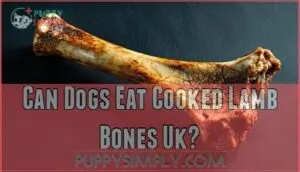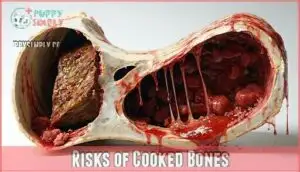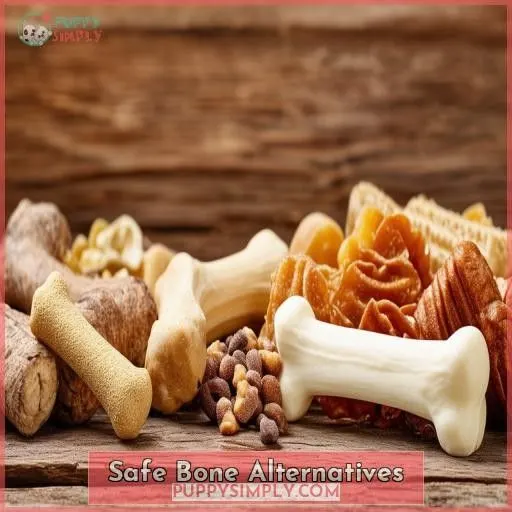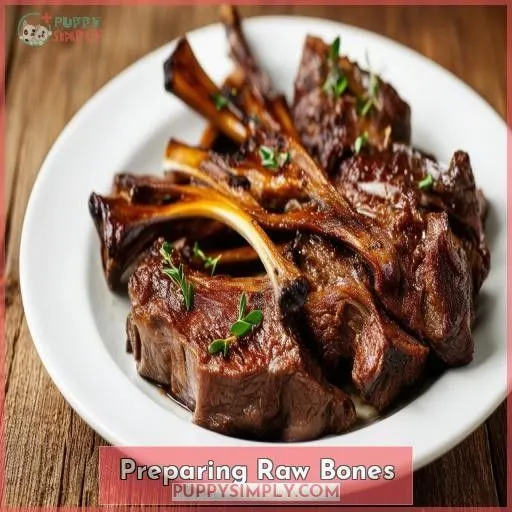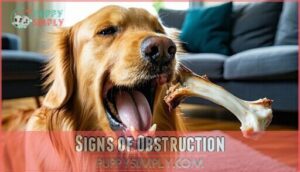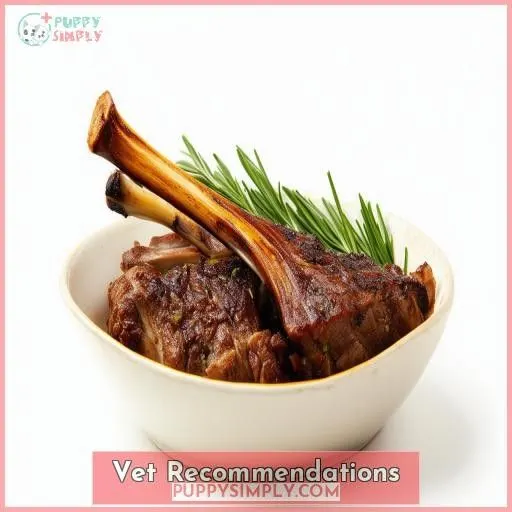This site is supported by our readers. We may earn a commission, at no cost to you, if you purchase through links.
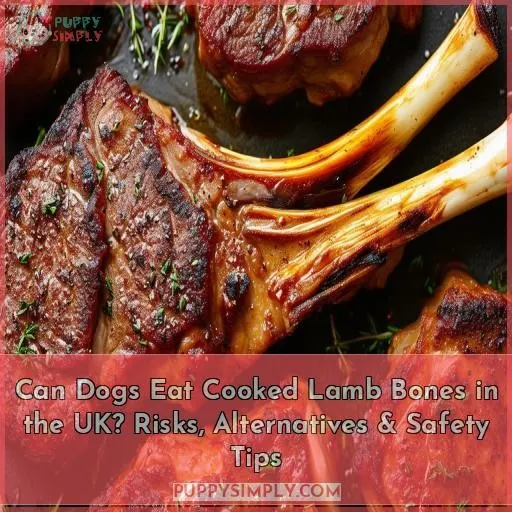
The risks simply aren’t worth it. Instead, provide safe chews like bully sticks or rubber toys that won’t damage their digestive system.
If you want to offer bones, opt for large, raw, weight-bearing bones and supervise closely. Watch for signs of obstruction like vomiting or constipation.
If your pup is in distress, don’t hesitate to seek veterinary care immediately. Learning the proper precautions can guarantee your furry friend stays happy and healthy.
Table Of Contents
Key Takeaways
- Feeding your furry friend cooked lamb bones can be a recipe for disaster – those brittle bones are just begging to splinter and wreak havoc on their insides!
- Skip the risky business and keep your pup’s tail wagging with safer chew options like bully sticks or rubber toys that won’t send you rushing to the vet.
- If you must indulge their bone-crunching cravings, go for the big, raw, weight-bearing ones and keep a watchful eye on your canine companion – you don’t want any shocking surprises!
- At the first sign of distress, like vomiting or constipation, don’t hesitate to call the vet – it’s better to be safe than sorry when it comes to your beloved furry family member’s well-being.
Can Dogs Eat Cooked Lamb Bones Uk?
No, dogs shouldn’t eat cooked lamb bones in the UK. Cooked bones can splinter and cause obstructions or punctures in a dog’s digestive tract, which can be life-threatening.
Risks of Cooked Bones
You must never feed your dog cooked bones, especially lamb bones.
As they’ve been cooked, these bones become dry and brittle, increasing the risk of splintering. If your pup swallows splinters, they can cause serious internal damage by getting lodged in the digestive tract or puncturing organs.
This often leads to constipation, vomiting, a sore abdomen, and may even require surgery. Cooked bones also have an increased choking hazard due to their softened texture.
Protect your furry friend by avoiding all cooked bones to prevent potentially life-threatening digestive tract damage.
Safe Bone Alternatives
Regarding safe bone alternatives for dogs, you have two primary choices: edible chews and recreational chews. Edible chews, such as bully sticks or dried tendons, can provide nutritional benefits, while recreational chews, such as rubber or nylon toys, offer a secure outlet for chewing without the risks associated with cooked bones.
Edible Chews
Edible chews can be a safe alternative to cooked lamb bones, providing nutritional value without the risks of gastrointestinal obstruction. Look for large, hard chews made from ingredients like bully sticks, dehydrated meats, or edible dental chews that are digestible and less likely to pose a choking hazard for your pup.
Recreational Chews
For recreational chews, you’ll want large, heavy bones that are difficult for your pup to break apart. Beef knuckle bones or ham bones make great, long-lasting options. Always supervise when giving these, and take them away once they become small enough to swallow. Consider safer alternatives like bully sticks or antlers for unsupervised chewing.
Preparing Raw Bones
When selecting raw bones for your dog, choose larger, weight-bearing bones like lamb femurs or beef knuckle bones, as they’re less likely to splinter or be swallowed whole. Portion sizes should be based on your dog’s size and chewing ability – start with smaller portions for puppies or seniors and modify as needed.
Bone Selection
When selecting raw bones, choose size and type carefully. Large, dense bones like beef knuckle or leg bones work well, while small bones can splinter. Avoid bones with high marrow content, as these tend to be more fragile. Always supervise when giving bones to prevent choking or obstruction risks.
Portion Sizes
Don’t overdo it—give age-appropriate portions. For puppies, start small—just a few inches per week. As they grow, you can offer larger lamb bones, but supervise closely. Pay attention to difficulty eating and consult your vet if you notice discomfort or changes in their stools. Remember, safety first!
Signs of Obstruction
You’ll want to watch for signs of obstruction if your dog has eaten cooked lamb bones, like vomiting, diarrhea, and lethargy. These could indicate bone fragments are causing a blockage or irritation in the digestive tract.
Vomiting
If you notice vomiting, lethargy, or loss of appetite in your dog after eating bones, it could signify:
- Gastrointestinal obstruction
- Abdominal pain
- Constipation
Seek vet care immediately for proper diagnosis and treatment.
Diarrhea
Along with vomiting, diarrhea can signal a bowel obstruction. Monitor your dog’s stool consistency, frequency, duration, odor, and presence of blood. With pet sitting services, experienced professionals can help assess any concerning symptoms.
Lethargy
If your pup’s lethargic, that could signify:
- Abdominal pain from obstruction
- Changes in gut flora
- Dehydration from vomiting
- Ear canal debris bothering them
- General malaise needing vet attention
Vet Recommendations
You should seek veterinary care immediately if your dog exhibits signs of an obstruction, such as repeated vomiting, abdominal pain, or an inability to defecate. Treatment options may include inducing vomiting, laxatives, endoscopic removal, or surgery, depending on the severity of the obstruction.
When to Seek Help
You’ll want to seek veterinary care immediately if your dog exhibits persistent vomiting, diarrhea, lethargy, or abdominal pain after ingesting a bone fragment. These could signal gastrointestinal irritation or obstruction, which requires prompt treatment to prevent complications.
Treatment Options
If your dog has swallowed a bone fragment, your vet may recommend an X-ray or endoscopy to locate it. Depending on the situation, they might suggest inducing vomiting, providing fluids and bland foods to help pass the fragment, or even surgery to remove an obstruction. Always follow your vet’s advice for your pup’s safety and recovery.
Frequently Asked Questions (FAQs)
Can you give a dog a cooked lamb bone?
No, you shouldn’t give your dog cooked lamb bones. They can splinter and cause internal injuries or obstructions. Stick to raw bones or safer chew toys to prevent gastrointestinal issues.
What cooked bones can dogs eat?
You should never feed your dog cooked bones of any kind, including lamb bones. Cooked bones can splinter and cause serious internal injuries or obstructions. For your dog’s safety, it’s best to avoid all cooked bones and instead provide appropriate chew toys or raw, edible bones approved by your veterinarian.
How to prepare a lamb bone for a dog?
To prepare a lamb bone for your dog, remove any cooked portions and small bits that could splinter. Provide large, raw, weight-bearing bones under supervision. Avoid giving cooked bones as they’re prone to splintering and causing obstructions.
Are lamb ribs good for dogs?
Lamb ribs can be a good option for dogs. They’re large enough to chew without splintering and provide nutrients. However, always supervise your pup when giving bones and discard smaller pieces to prevent choking hazards or intestinal blockages.
Can dogs eat lamb bone marrow?
You can feed your dog small amounts of lamb bone marrow occasionally as a treat. However, cooked bones pose a risk of splintering and should be avoided to prevent intestinal obstruction or punctures.
Are cooked lamb bones digestible?
No, cooked lamb bones aren’t digestible for dogs. The cooking process makes them brittle and likely to splinter, posing serious risks like perforations, blockages, or lacerations to the digestive tract. Stick to raw, edible bones for safer chewing.
How to introduce raw bones safely?
Gradually introduce raw bones under supervision. Start with large, hard bones like knuckles to prevent splintering. Always supervise and remove when it becomes a potential choking hazard. Provide plenty of fresh water.
What size bones are appropriate?
A bone to pick: Opt for knuckle bones or femurs, around 6-8 inches. These hefty, tooth-sized treats provide safe chewing satisfaction for jaws on the prowl.
Conclusion
All things considered, letting Fido gnaw on cooked lamb bones in the UK is not worth the risks.
Make a beeline for safer edible and rubber chews instead.
If you cannot resist giving raw bones, choose weight-bearing ones and keep a hawk-eye out for signs your pup is in distress.
Do not delay – call the vet as soon as possible if you suspect an obstruction from ingesting cooked lamb bones.

